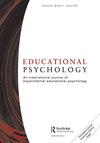寻求勇气:勇气是如何与寻求感觉和道德联系在一起的
IF 3
2区 心理学
Q1 EDUCATION & EDUCATIONAL RESEARCH
引用次数: 0
摘要
引言:勇敢的行为可能由基因(天赋)和环境(教养)决定。本研究的目的是描述参与者的陈述性勇气水平与感觉寻求特质强度之间的关系。为了研究的目的,勇气被定义为面对风险采取行动的意愿(Woodard,2007)。方法:本研究采用问卷调查法,采用Woodard-Pury勇气量表-23(WPCS-23)、简明感觉寻求量表(BSSS)、波兰改编的道德基础问卷(MFQ-PL)测量所选特质变量的水平。出于研究目的,WPCS-23和BSSS被翻译成波兰语,并由原始版本的作者进行了反译。结果:感觉寻求的一般指标与勇气呈正相关;此外,经验寻求、冒险和兴奋寻求与勇气有关,而不是对无聊和脱离的易感性。寻求经验、寻求冒险和寻求刺激是受访者勇气水平的预测因素。道德结构与参与者的勇气关系不大。没有任何道德准则可以预测勇气。结论:本研究旨在探讨情感寻求与不同类别的勇气道德以及社会环境中人类行为的本质之间的关系。我们对受访者的感知结构感兴趣,以及在做出决策时,哪些特质/价值观指导他们。这项研究已经证明,寻求感觉是勇气的预测因素。参与者的道德与勇气几乎没有关系。在进一步的研究中,我们建议用更大的、有代表性的样本来关注勇气、情感追求和道德的社会方面。本文章由计算机程序翻译,如有差异,请以英文原文为准。
Seeking courage: how courage is linked with sensation seeking and morality
Introduction: Courageous behaviour could be determined by both genes (talent) and environment (upbringing). The purpose of this study is to describe the elationship between participants levels of declarative courage and the intensity of the sensation-seeking trait. For the purposes of the study, courage was defined as the willingness to take action in the face of risk (Woodard, 2007). Method: The study was conducted using a questionnaire method, the level of selected trait variables was measured using the Woodard Pury Courage Scale-23 (WPCS-23), Brief Sensation Seeking Scale (BSSS), Polish adaptation of the Moral Foundations Questionnaire (MFQ-PL). The WPCS-23 and BSSS were translated into Polish for the purposes of the study in a backtranslation the authors of the original versions. Results: The general indicator of sensation seeking has been shown to be positively related to courage; moreover, experience seeking and adventure and excitement seeking have been shown related to courage stronger than susceptibility to boredom, disengagement. Experience-seeking, adventure-seeking and excitement-seeking are predictors of respondents levels of courage. The structure of morality has little relation to the courage of participants. No moral code is a predictor for courage. Conclusions: The study was conducted to explore the relation between sensation seeking and different categories of morality with courage and the nature of human behaviour in social situations. We were interested in the structure of sensationseeking among the respondents and what traits/values guide them when making decisions. This study has proven that sensation seeking is a predictor of courage. The participants morality has shown little relationship to courage. In further research, we suggest focusing on the social aspectsof courage versus sensation seeking and morality with a larger and representative sample.
求助全文
通过发布文献求助,成功后即可免费获取论文全文。
去求助
来源期刊

Educational Psychology
Multiple-
CiteScore
6.40
自引率
6.20%
发文量
57
期刊介绍:
This journal provides an international forum for the discussion and rapid dissemination of research findings in psychology relevant to education. The journal places particular emphasis on the publishing of papers reporting applied research based on experimental and behavioural studies. Reviews of relevant areas of literature also appear from time to time. The aim of the journal is to be a primary source for articles dealing with the psychological aspects of education ranging from pre-school to tertiary provision and the education of children with special needs. The prompt publication of high-quality articles is the journal"s first priority. All contributions are submitted "blind" to at least two independent referees before acceptance for publication.
 求助内容:
求助内容: 应助结果提醒方式:
应助结果提醒方式:


